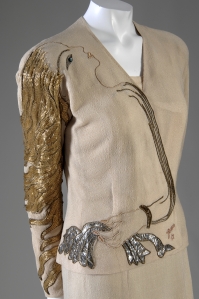Elsa Schiaparelli was born in Rome from the perfect marriage of Science and Aristocracy, in fact her father was a renowned scholar and curator of medieval manuscripts and her mother the representation of unconditional love for beautiful life in fact she was a neopolitan aristocrat. Elsa in writing her biografy tells how people, ever since she was a little child, reacted to her unusual beuty (saing it democratically) or beautuful ugliness (how she defines her self) in fact when she'll move to Paris many artists and devoted photographers will call her ''La Belle Brute''. Elsa was the most famous fashion designer douring the period between the two World Wars along with Coco Chanel her greatest rival. But she didn't adapt to the fashion changes after WWII and her business closed in 1954 and this, not to be mean is what probably saved Coco's business.
Schiap, another nickname with wich friends used to call her, possesed a remarkable personality and a telent of adaptation to difficult situations (a quality that is noticeable in all the big characters that emerged in that period) in fact she worked as a nanny when arrived in Paris.
The wide range of her closest and dearest friends comprehed personalities like that of Alberto Giacometti and Salvador Dalì that always sustained her along with her wife, one of Elsa's most devoted clients, like also the heiress Daisy Fellowes and the actress Mae West that also inspired the shape of the first bottle of perfume Schiapparelli produced.
Here there are some of her most famous designs:
The skeleton dress that Dalì helped Elsa to realize for the Circus Collection, a stark black crepe dress which used trapunto quilting (later on used also by Chanel)



The perfume that Schiaparelli launched in 1937 and was called 'Shocking' due to the bright pink of the packaging. This colour was inspired by a Cartier pink diamond owned by Daisy Fellowes.
The Tears Dress The Tears Dress, a slender pale blue evening gown printed with a Dali design of trompe l'oeil rips and tears, worn with a thigh-length veil with "real" tears carefully cut out and lined in pink and magenta, was part of the February 1938 Circus Collection. The print was intended to give the illusion of torn animal flesh, the tears printed to represent fur on the reverse of the fabric and suggest that the dress was made of animal pelts turned inside out. Figures in ripped, skin-tight clothing suggesting flayed flesh appeared in three of Dali's 1936 paintings, one of which, Necrophiliac Springtime, was owned by Schiaparelli; the other two are The Dream Places A Hand on a Man's Shoulder and Three Young Surrealist Women Holding in Their Arms the Skins of an Orchestra.
This is the representation of Schiaparelli's famous trompe l'oeils.
The Lobster dress a simple white silk evening dress with a crimson waist band featuring a large lobster painted (by Dalì) onto the skirt. In fact from 1934, Dalì started inorporating lobsters into his work including New York Dream-Man finds Lobster in Place of Phone. This dress was worn by Willis Simpson in a series of Photographss by Cecil Beaton taken at the Chateau de Candè shortly before the marriage to Edward VIII.

In 1933, Dali was photographed by his wife Gala Dalì with one of her slippers balanced on his head. In 1937 he sketched designs for a shoe hat for Schiaparelli, which she featured in her Fall-Winter 1937-38 collection. The hat, shaped like a woman's high heeled shoe, had the heel standing straight up and the toe tilted over the wearer's forehead. This hat was worn by Gala Dali, Schiaparelli herself, and by the Franco-American editor of the French Harper's Bazar, heiress Daisy Fellowes, who was one of Schiaparelli's best clients.
After the ''failure''...
Even if the name of Elsa Schiaparelli is not know as that of her rival and 'survival', to WWII changes, Coco Chanel Time's magazine placed Chanel in the second division of Fashion whereas Schiaparelli was one of ''a handful of houses now at or near the peak of their power as arbiters of the ultra-modern haute couture....Madder and more original than most of her contemporaries, Mme Schiaparelli is the one to whom the word "genius" is applied most often"
At the same time Time recognised that Chanel had assembled a fortune of some US$15m despite being "not at present the most dominant influence in fashion", whereas Schiaparelli relied on inspiration rather than craftsmanship and "it was not long before every little dress factory in Manhattan had copied them and from New York's 3rd Avenue to San Francisco's Howard Street millions of shop girls who had never heard of Schiaparelli were proudly wearing her models".
Perhaps Schiaparelli's most important legacy was in bringing to fashion the playfulness and sense of "anything goes" of the Dada and Surrealist movements. She loved to play with juxtapositions of colours, shapes and textures, and embraced the new technologies and materials of the time. With Charles Colcombet she experimented with acrylic, cellophane, a rayon jersey called "Jersela" and a rayon with metal threads called "Fildifer" - the first time synthetic materials were used in couture. Some of these innovations were not pursued further, like her 1934 "glass" cape made from Rhodophane, a transparent plastic related to cellophane. But there were more lasting innovations; Schiparelli created wraparound dresses decades before Diane fon Fustenberg and crumpled up rayon 50 years before Issey Miyake's pleats and crinkles. In 1930 alone she created the first evening-dress with a jacket, and the first clothes with visible zippers. In fact fastenings were something of a speciality, from a jacket buttoned with silver tambourines to one with silk-covered carrots and cauliflowers.



oh god! I have realized only now the amount of mistakes i have made, but it's forgettable since it's my first post and my ability of using technology is equal to 0.
ReplyDelete